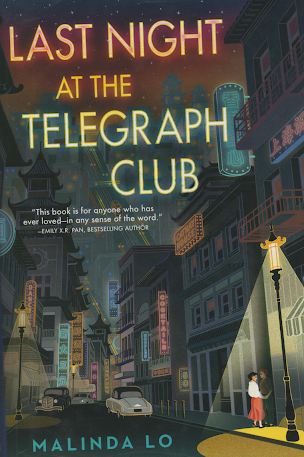First impressions review: Last Night At The Telegraph Club, by Malinda Lo
This historical fiction follows Lily Hu, growing up in San Francisco’s Chinatown in the 1950s and realizing she is in love with her classmate, Kathleen Miller. But it also has flashbacks to earlier episodes in the life of her parents and aunt that give more depth and variety to the depiction of Chinese-American life in the mid-twentieth-century. The titular Telegraph Club1 that is both a welcoming and affirming place for Lily and Kath and a danger, given the frequency of raids and how association with leftists or homosexuals could be used as an excuse for deportation in this time period, not to mention general social ostracism. However, although there are some scary moments, this is overall a really sweet, uplifting, hopeful story.
1. Fictional, but based on several real San Francisco lesbian clubs that featured ‘male impersonators’.
Lo does a terrific job of bringing to life the sights, smells, and tastes of the places she is depicting (and there are notes in the back explaining her process). This San Francisco will feel very recognizable to anyone who has been there recently but is also clearly an older version of itself. For instance, it’s already pretty gay…just in a quieter way than now! Chinatown is the most fleshed out, and Lo uses language to lend authenticity. Lily’s favorite foods are given their Chinese names, and when she and her family speak Cantonese or Mandarin the old-style characters are used in the text with footnote translations.
There’s a science and math element to this story that I enjoyed. Lily and Kath are both taking advanced math and bond over similar career ambitions: Lily wants to help design rockets like her “computer” aunt who works at the Jet Propulsion Lab, and Kath wants to be a pilot. Apart from the aunt, the other examples of female pilots, mechanics, and scientists included are also implied to be gay. On the one hand, it makes sense why they are brought up or why Lily notices them – she has more than one reason to identify with them. However, (and I can’t believe I’m saying this) I would rather there had been a few more straight (or bi) STEM ladies included, because the current lineup kind of accidentally implies there is something inherently “butch” about science – which there isn’t! Lily and Kath’s sexuality and gender presentation is a separate issue from their career ambitions…mostly. Given how science was assumed to have a masculine flavor in that time period, I could see a certain filtering happening, particularly at the higher levels. If you were a woman who didn’t mind being perceived as mannish or weren’t trying to land a husband, you might well have a better shot at promotion/being perceived as “one of the guys”. That could actually be a whole interesting historical exploration on its own!
I really liked the portrayal of Lily’s family as well. You can see all of them grappling with what it means to be Chinese and American in their separate ways, and you also get to see the internal cultural conflicts between Mandarin- and Cantonese-speaking Chinese Americans. Her father is a doctor who was a WWII medic and who wanted to go set up a clinic in China with her mother (a nurse) after the war. But, because of the revolution, that never happened, and now he is under pressure by US law enforcement to inform on patients suspected of being Communists. Her mother is trying to keep the family safe by being as respectably American-looking as possible, which her husband (who stubbornly refuses to lie) and Lily do not make easy! Aunt Judy is great. She encourages Lily’s interest in science and, though she doesn’t fully understand her niece’s feelings for Kath, she doesn’t throw a fit but rather makes sure Lily knows she is loved and that she will have support as she’s working through those feelings. Lily’s childhood friend Shirley is a character I loved to hate. She’s definitely got “queen bee” energy, and she is not nearly as good a friend to Lily as vice versa, but she’s believable as a person, as you can see she has her own secrets and insecurities that make her the way she is.
It feels weird to say I liked the depiction of how Lily’s identities intersect, because it is meant to be uncomfortable. The Telegraph Club feels like home to part of Lily, but the language used to describe her ethnicity by white lesbians who are trying to be friendly - and by more and less friendly people outside the club scene as well - is pretty offensive by 2020s standards, and you can tell that Lily doesn’t care for it either. She’s doesn’t react too negatively to being called a “China doll” by her singer idol, but she shrinks a bit into her chair every time someone points her out.
“We don’t see many Orientals around here,” Sal said to Lily. “Do you speak English? Where are you from?” Lily stiffened. “Chinatown. I was born here.” Sal looked impressed. “You don’t even have an accent. That’s amazing.” “I was born here,” Lily said again, a bit more sharply.
We don’t see much of Kath’s Irish Catholic family. I suspect she might also run into weird assumptions, and there is implied to be quite a scene at home after she gets caught at the Telegraph Club. None of that is on-page, perhaps because the author wanted to stick with what she knows, and not pad out the story excessively…but if this were ever adapted it might be nice to add a couple of those scenes.
Overall recommendation: If you like immersive historical fiction, and think you would enjoy a female-female romance that doesn’t shy away from the stuff that would make such a relationship hard in a past time period but which isn’t tragic either…this is the book for you!


